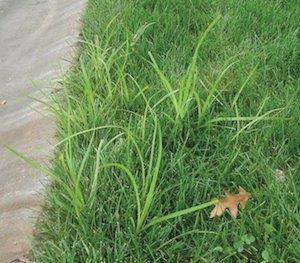
When timely rainfall happens in the spring, our lawns grow quite nicely. In addition to the grass, however, summer weeds also start to appear. One of the most difficult lawn weeds to control goes by several names including nutsedge, nutgrass and water grass. The technical name is yellow nutsedge. Although this weed looks like a grass, it is really sedge, one of a group of plants that have triangular stems. As the name implies, yellow nutsedge is pale green to yellow in color. It grows rapidly in the spring and early summer, often sticking up above the rest of the lawn only a few days after mowing.
Nutsedge grows best in moist lawns, often with poor drainage. The weed can also be introduced into better soil conditions through contaminated topsoil or nursery stock. As with many weeds, nutsedge is less competitive in a dense, healthy lawn than in a poorer, thinner turf.
Pulling nutsedge environmentally friendly but takes time
Nutsedge is difficult to control culturally because it produces numerous tubers that give rise to new plants. Pulling nutsedge will increase the number of plants because dormant tubers are activated. However, it is possible to control small stands of nutsedge by persistent pulling. Pulling will eventually weaken the plants and cause them to die out.
Using herbicides to control nutsedge
Herbicide treatments are the best way of controlling this pesky weed. If an infestation is not too severe, one application should take care of the problem. Since nutsedge is not a grassy or broadleaf weed but sedge many of the common herbicides available to the consumer will have little or no effect on its control. No matter what you call it, nutsedge, nutgrass or water grass, be sure to call Dreamlawns for the best control of this lawn weed problem.


Dreamlawns provides superior lawn care service to Virginia Beach & Chesapeake VA residents.




